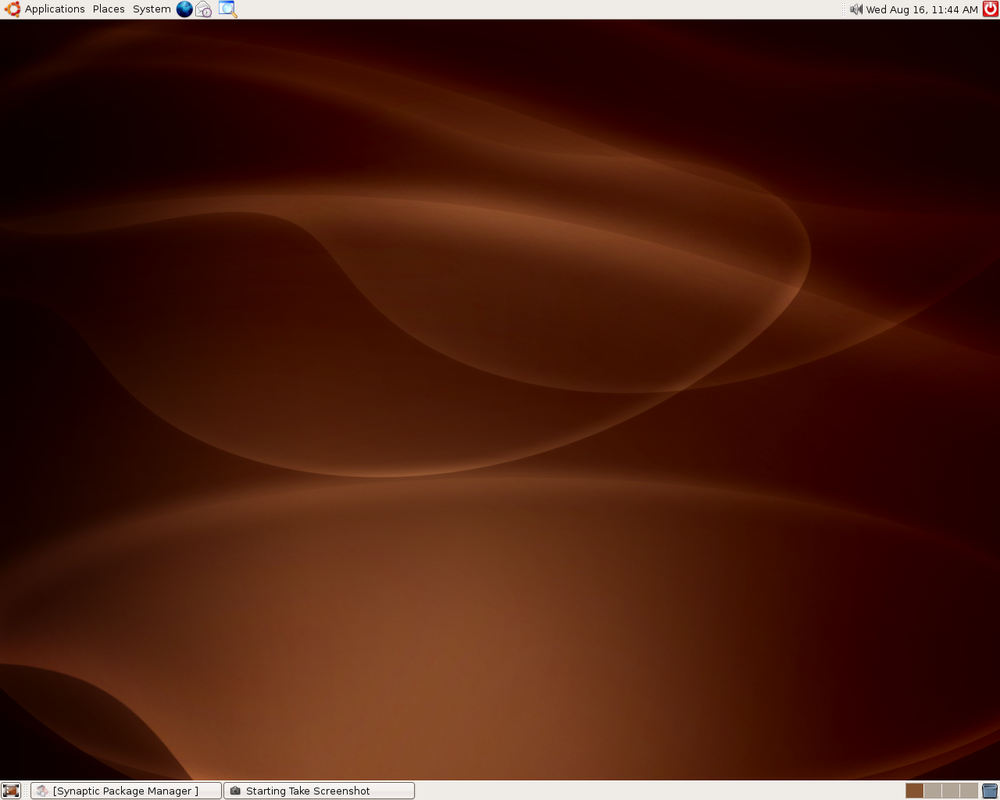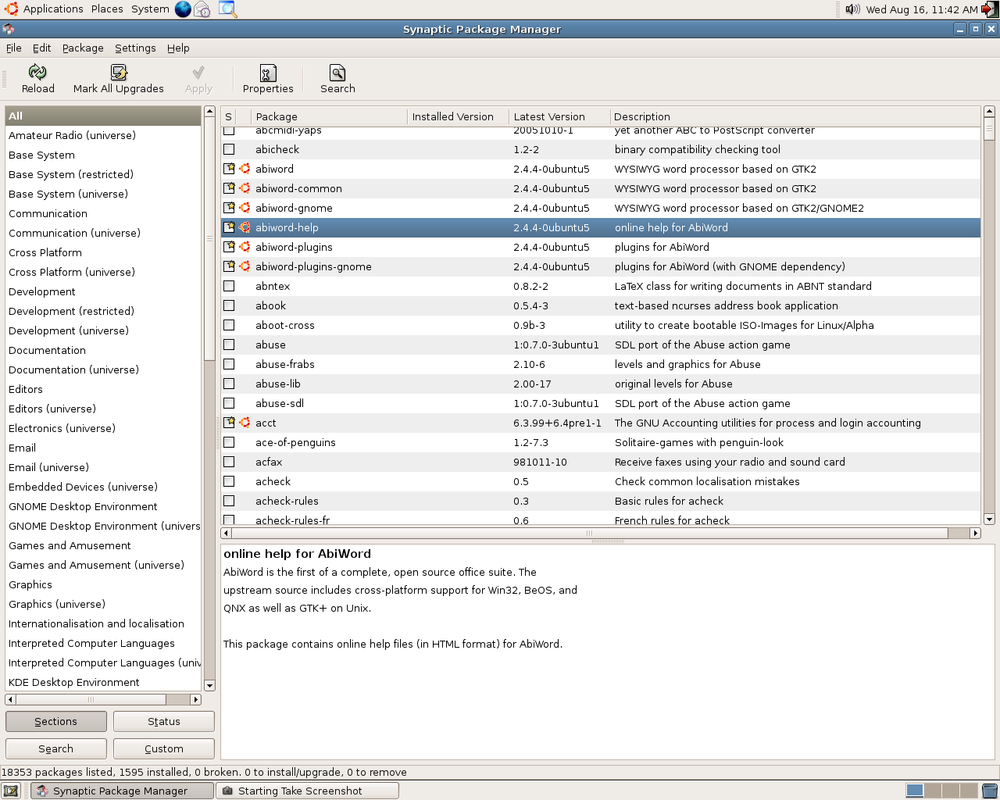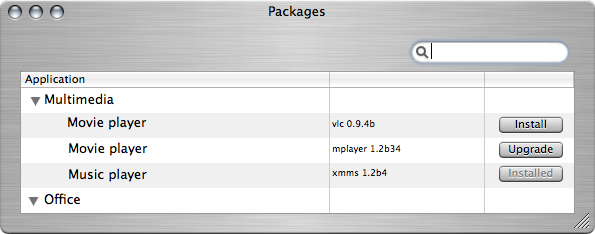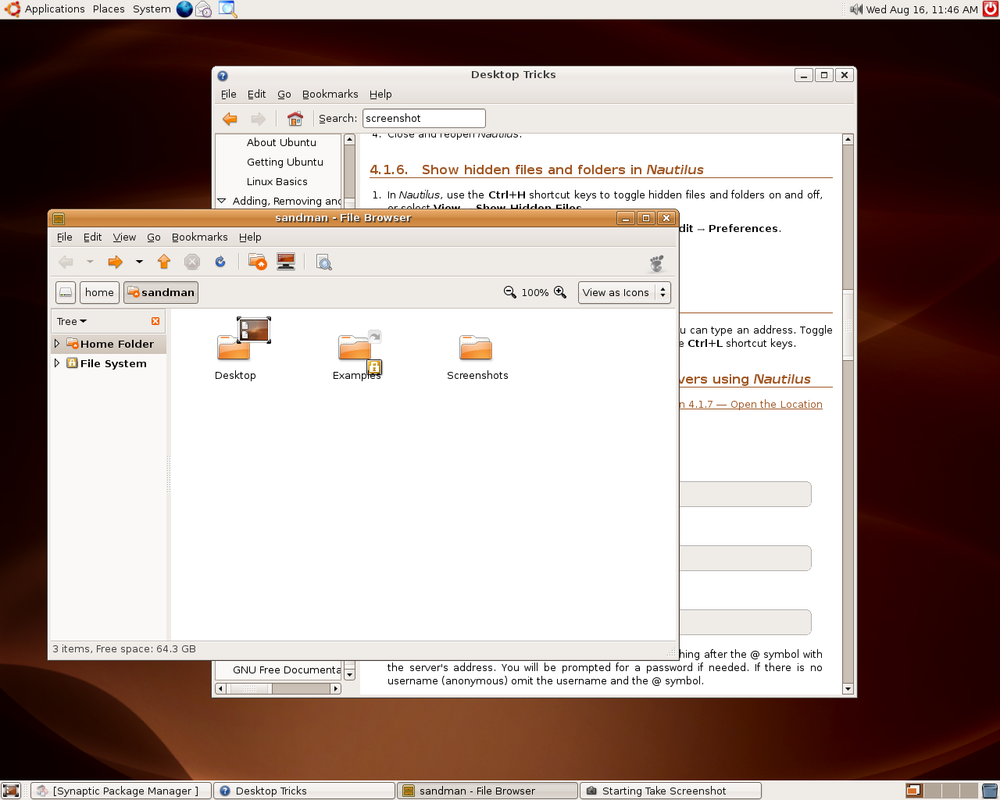So, instead of installing linux on my high end ATI-powered gaming PC (since some said that GPU acceleration wouldn't work) I took an older 1.8Ghz P4 machine with 768MB of RAM and plugged an older nVidia GeForce 5900XT card in it.
So, what were my impressions?
Installation
I popped the DVD in the box and saw the "Install Ubuntu" choice at the top, hit return. Since I did this at work, I continued to work. Next time I looked at the PC I saw a desktop running the Human theme... Uh, wtf? Ok, if it installed the entire system and was up and running without any intervention then that's just awesome..
But as it was, this was Ubuntu Live running. Huh. I remember that the choice said install... Maybe me being away from the screen made some other screen timeout from the choice of running Live and installing and went with the default, which in this case would be live.
Anyway, I played around some, and found, in the menu, a "Install this to hard drive", which I choose.
I was asked about some information for my account and whether I wanted to wipe the harddrive or partition it. Apart from "partition" being something regular users knows nothing about, the install was very smooth. It didn't ask for my network setup which I suppose is ok. DHCP is probably the most common network setup for regular users, and if you have static IP you know a little more about network setup. But, a settings assistant should have popped up upon installation saying that network didn't seem to be working.
Installation was a breeze. If you only can get people to download and burn a Linux CD, installing it is not a problem.
Speed
So, 1.8Ghz P4 machine. Not state of the art by any stretch of the imagination, but compared to OSX running on, for instance, a 400Mhz G3 iMac with 192MB of RAM, Linux performs extremely slowly. It is by far the slowest desktop I've been in contact with. Opening applications takes several seconds at least. Even opening the terminal application can take up to five seconds. Searches in the help documentation (which is otherwise in pretty good shape) takes a long time. Windows aren't double buffered so when you're doing something they become giant erasers (or giant brushes, leaving trailing window borders behind). I know that lots of Linux advocates tout that Linux is fast on older hardware, but this is painfully slow. Not "something must be misconfiguredly slow", but almost. At first I thought this was due to GXL not being configured, but it turns out that it wasn't so.
Package installation
Ubuntu ships with Synaptic for package management. Upon launch it lists all packages by name, so you have a long list of extremely cryptic names. They really really should do something about this. Categorize it better, name all packages in human-readable form. Something in the shape of:
I know about "sections", that's not it. There are literally thousands of packages in synaptic, but only a handful of them are important to the regular user. Hide the rest under "advanced". Regular users doesn't need "gtk2-engines-mist". Plus, I don't like the two-phase process of first marking packages, and then "Apply":ing the selections. It should be multithreaded and an action button next to each item (like in my ascii version above) and pressing install should install the package, only alerting the user if it has to remove something in order to install it.
Other than that, installations were veery smooth, and even the first upgrade (there are 191 packages to upgrade after launch!) were pretty fast and smooth, and while it could have broken the entire system, it worked really fine.
KDE/Gnome
Ubuntu is gnome, so utility apps and such are gnome apps. I wanted to try out the latest KDE, so I installed that package in synaptic, which in turn installed some 30+ more packages. Upon re-login, it locked pretty much identical. Hmmm, ok... But the applications in the menues were all different... Konsole instead of Terminal and things like that. Huh. Other than that, nothing seem to have changed. As far as I can find, there isn't somewhere I can pick what window manager that launches at login.
So I looked at kubuntus homepage and there it said that if I install "kubuntu-desktop" on top of ubuntu, I get kubuntu. Aha, ok. So I did. A shitload of packages were downloaded and installed, and upon re-login (and even restart of the X-server - it asked if I wanted to run kdm or gdm, I chose kdm) still nothing has changed. So how do I change to KDE? Am I running KDE and they are identical? Who knows? 
Other than that, the Preferences and settings seems straightforward enough for a regular user. Network settings were easy enough to set even for someone novice.
GPU hardware acceleration
I noticed that screen redraw wasn't as fast as it could be. Especially when the screen dimmed when asking for a admin password. So I figured that I wanted to enable that. Sure enough, all the information I should need was in the help documents. If I have a new enough nvvidia card, install "nvidia-glx", then run "nvidia-glx enable" as root. Sure thing! Oh, but first I have to enable multiverse support in the repositories, which is explained in another help section. I really think the option of searching the multiverse should be asked in synaptic upon completing a search, like:
There was 41 matches, do you want to search in the
unsupported packes?
Not as a dialog, but as a small pane in the bottom of synaptic
Anyway, having run nvidia-glx I restarted the X server... Ooops, it didn't come back! Trying to start it from the shell just produced lots and lots of errors. Hmmmm
Now, I'm really not X-savvy enough to troubleshoot this on account of the errors. I rolled back the xorg.conf file and tried a series of different installations with nvidia-glx and nvidia-glx-legacy. In the end, I think running "nvidia--xconfig" after enabling it did the trick, which wasn't mentioned in the help files (only nvidia-settings, which is a X app and tweaks nvidia settings when they actually work.
Ok, so now I have X launched, with nVidia support... but only 1024x768 on my 1280x1024 monitor! Eh?? Monitor resolution preferences didn't list anything higher...
In the end, I ended up manually editing /etc/X11/xorg.conf with pico to add "1280x1024" to all display configurations. If it hadn't been for the fact that I've done this like a million time back in 1994-1999 then I would have been utterly lost. Plus, if I didn't know how to rollback the, by nvidia-glx, altered xorg.conf files, I'd been stuck with a unusable system.
In the end - GLX should be autoconfigured upon installation. It shouldn't be an add-on. And it does make a difference, since it speeds up the screen redraw to remove that kind of sluggishness on this system.
XGL
With GPU acceleration, I wanted to try out XGL (http://www.freedesktop.org/wiki/Software/Xgl)! So I installed it from the multiverse and ... then what? Hmmm... How do I choose what X server to launch? I don't know. I realize that XGL isn't for regular users, so I don't expect it to have a user friendly installation, but I just don't know how to enable it... Hmmm. And as it seems - this is the only GPU-accelerated X server for Linux, and it's still in beta. I wanted this because I wanted to compare it to Quartz Extreme on my Mac, which has been there for years.
Interface
It's getting there, but has a long way to go. Windows aren't double-buffered, like in Windows, so they end up having lots and lots of UI artifacts when moved around (eraser/brush phenomenon).
Other than through the pre-set menues, there is no way to see "all applications". Under the "Places" menu, there are stuff like Home, Desktop, Network and such, but not "Applications". What's up with that? And I'm not comparing it to the "All applications" in the Start menu, but the /Applications folder in OSX.
Installing new applications is a point-and-click operation, but then what? If you're lucky, it's added to the menu, but you don't know what menu because the developers decides where it goes. VLC player, for instance, installes in "Sound & Video" which is perfectly logical, but it was installed *from* the "Multimedia" section in synaptic. Better and consistent grouping is needed here. Plus, a dialog for GUI-applications that say something like "VLC Player has been installed in Applications->Sound & Video - do you want to start it now?"
Plus, repository managers have - in Linux - the excellent possibility to tag applications with keywords to create a truly dynamic application launcher. An application like mplayer or VLC could show up in "Multimedia->Video" and "Multimedia->Music" as well as in "Multimedia->Advanced->Encoding", dynamically, because it matches those tags.
Which brings us to Beagle. I used synaptic to install Beagle from the multiverse (since for some reason it's not included nor supported by ubuntu). After installation, it *didn't* put an icon in a menu as far as I can find (with ubuntu and kubuntu, my menus are getting a bit crowded). So how do I launch it? How do I search?
I ended up adding it manually to the panel to execute "beagle-search" which gives me the interface. I don't have lots of stuff (read: none) on this system, so I cant' comment on performance, but the interface seemed good enough.
Minor point - the help files doesn't mention if you can navigate the pager workspaces with the keyboard... can you?
Plus, there is a "take screenshot" application, but the help files doesn't seem to include information on how to take screenshots without it (i.e. pressing a keyboard combination to take a screenshot of a menu for instance).
Conclusion
Linux most certainly has come a long way. But it still has too much "tech savvy" legacy to get rid off before I could claim that it's ready for the desktop. It's noticable that KDE/Gnome does it's best to abstract the underlying unix foundation but when even the help files constantly point to executing things in the shell and when the file system is more or less hidden for common tasks such as finding Applications it means that it's still some way to go.
But that's not really critisizm. Linux is really excellent, and for someone stuck with Windows it would be a step up in many ways (and a step down in some of course). OSX, being a refined Unix still shines in comparison, and all UI preferences aside, it's clear that OOSX UI has had more work put into it being a more polished and user friendly.
Not to mention all the features that OSX has by default that are beta add-ons for Linux found in unsupported repositories. Which of course is better than on Windows - where they don't even exist as that.
Kudos to Linux/Ubuntu/KDE/gnome for coming so far in a relatively short time. It's looking good for you guys.



